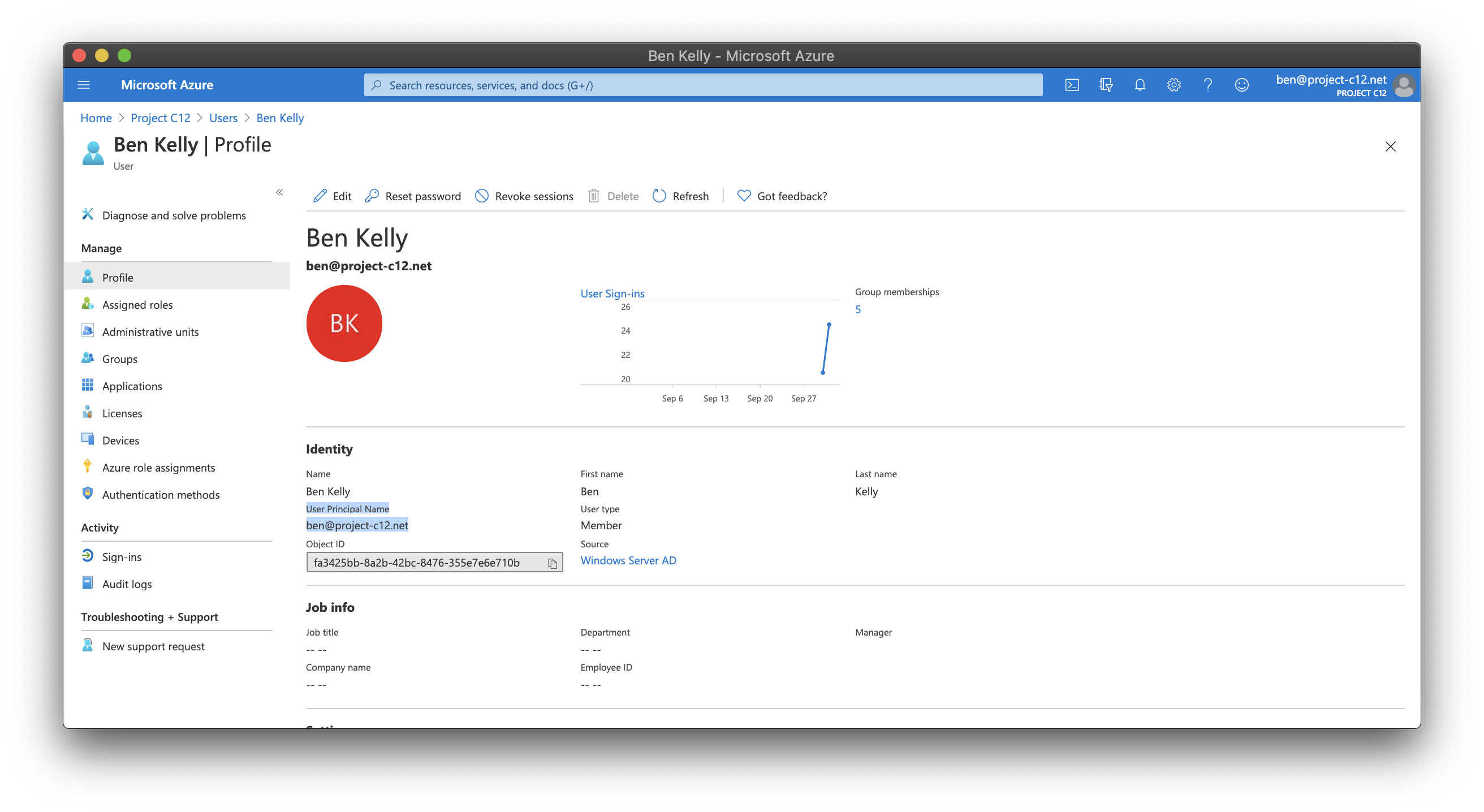- Admin access to Azure Active Directory Tenant.
- Abilities require to proform:
- Create Registart Applications.
- Create User Security Groups.
- Grant AAD Group Read roles to Service principle.
- Abilities require to proform:
-
Create Registered Application in Azure Active Directory portal located at portal.azure.com, and navigate to Azure Active Directory, and select App registrations.
-
Once there select
+New Registration and enter the name of your NiFi-AAD Application and also the Redirect URL to Be used by AAD to return to NiFi with the Users Authentication token. This will be your NiFi's domain followed by/nifi-api/access/oidc/callback, so for example a test Nifi on localhost with TLS enabled will behttps://localhost:9443/nifi-api/access/oidc/callback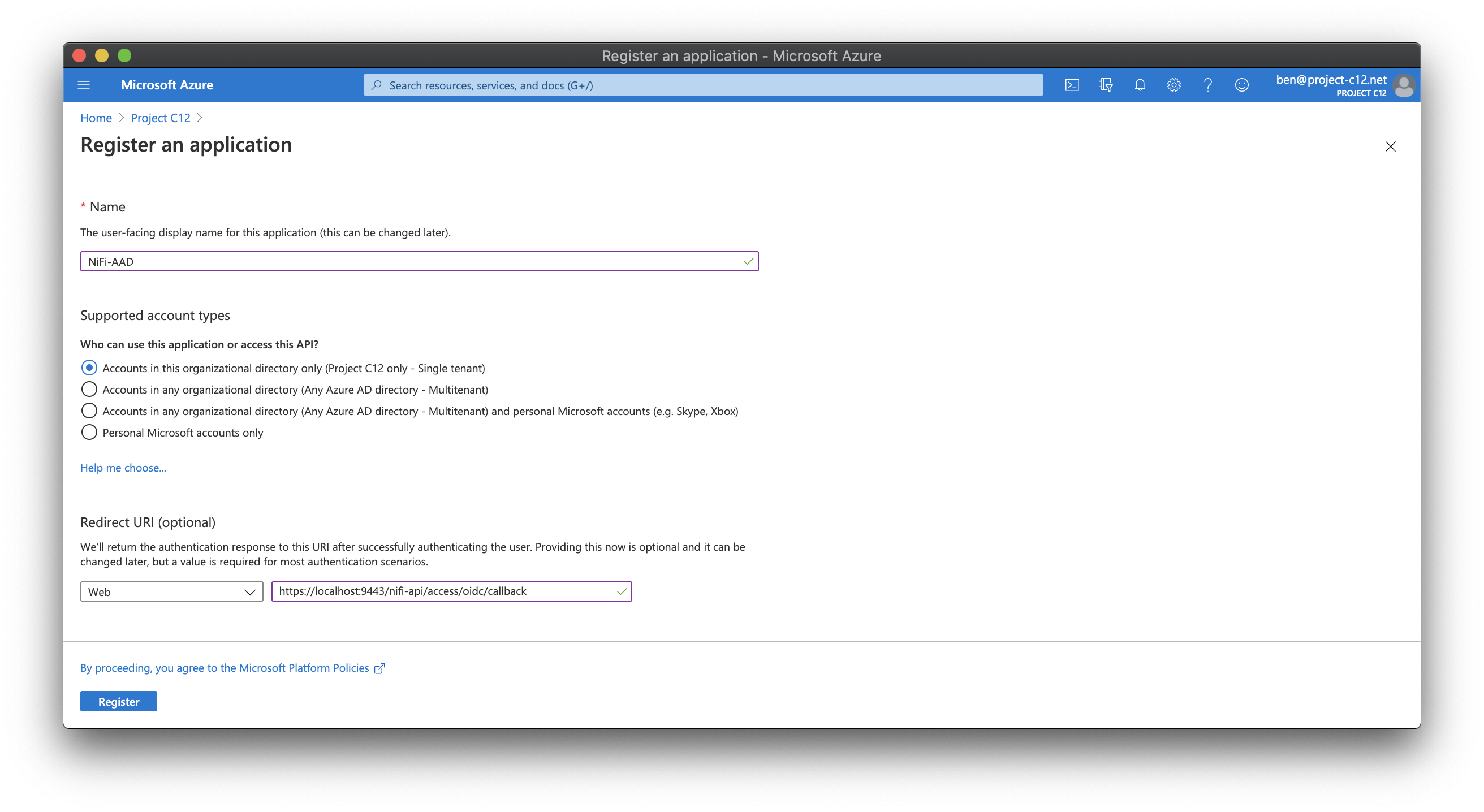
If your NiFi cluster is behind a load balancer, have its public DNS name in the host name part of the URL.
-
Once the Registered Application is created, note the Application (client) ID value referenced in the Overview property for the Application. This will be the
APP_REG_CLIENT_IDin theconf/authorizers.xmland thenifi.security.user.oidc.client.idinconf/nifi.properties -
Now to create a Client sectet, navigate within its properties to Certificates & secrets and create a new Client secrets this will be used for the
APP_REG_CLIENT_SECRETin theconf/authorizers.xmland thenifi.security.user.oidc.client.secretinconf/nifi.properties. -
Now Grant this App the following roles
Group.Read.AllandUser.Read.Allin the API permissions property. Remembering to apply the ✅ Grant Consent for YOUR_TENANT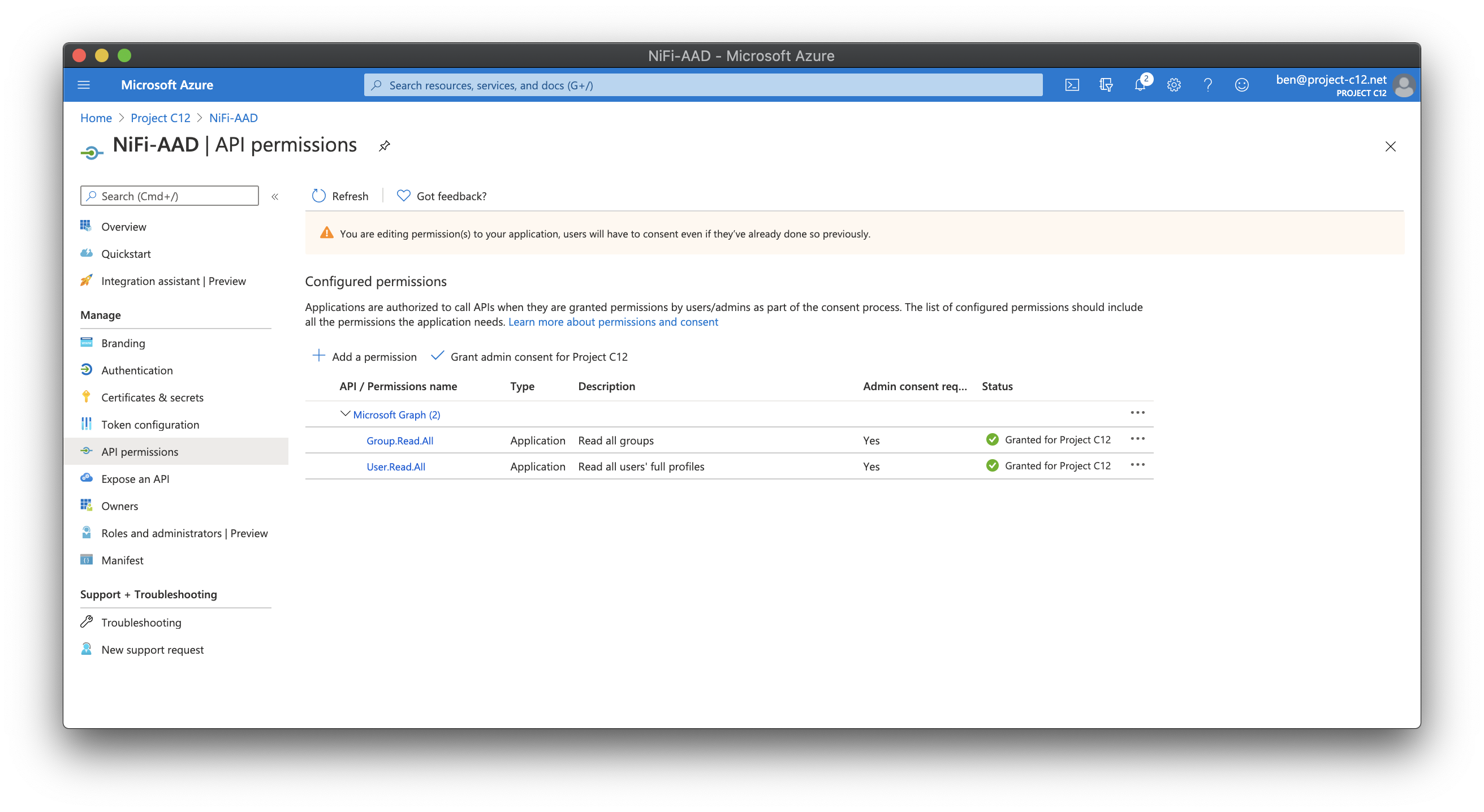
-
Now an Extra token is required for OpenID to authenticate successfully from the User Principal Name (UPN) which can be done by navigate within its properties to Token configuration and create a new token by selecting Add optional claim. For Token type choose ID and then tick the box to Clam only UPN, create then click edit on the newly created claim and enable Externally authenticated
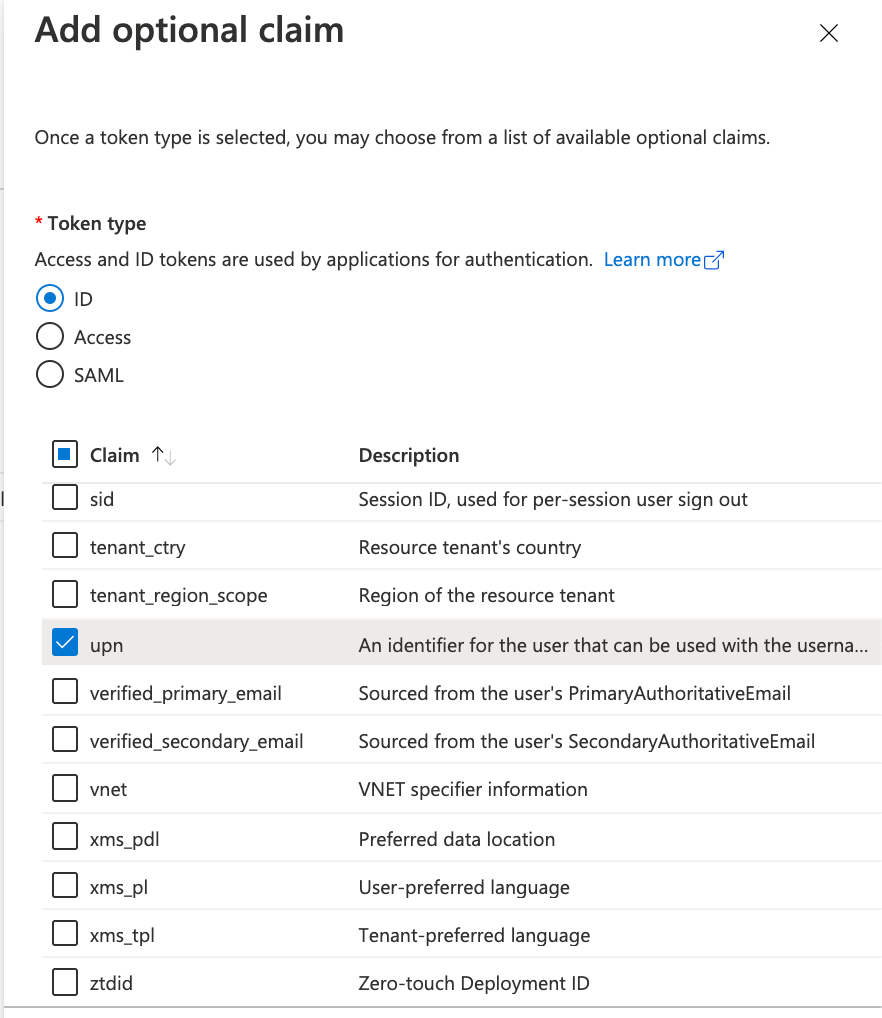
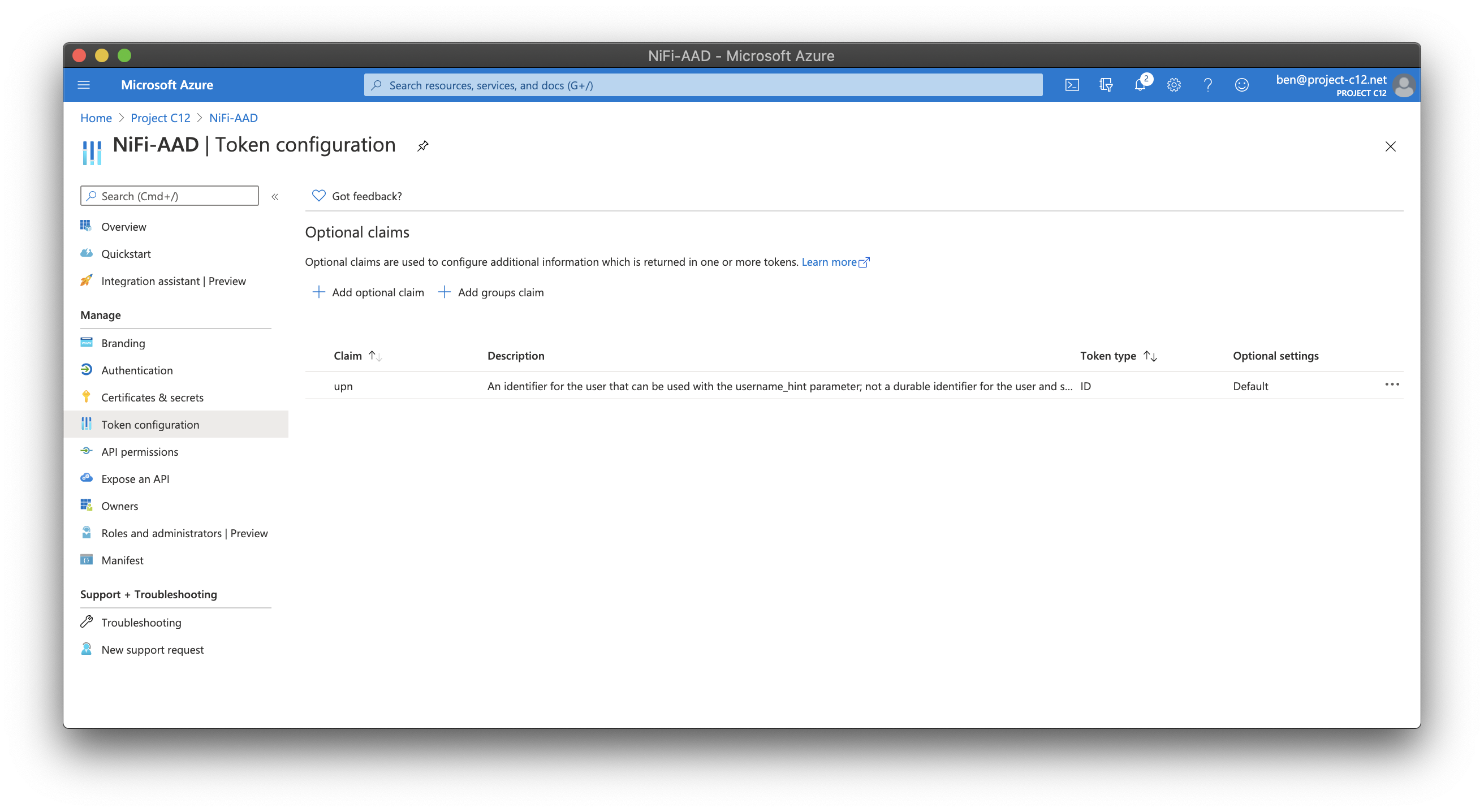
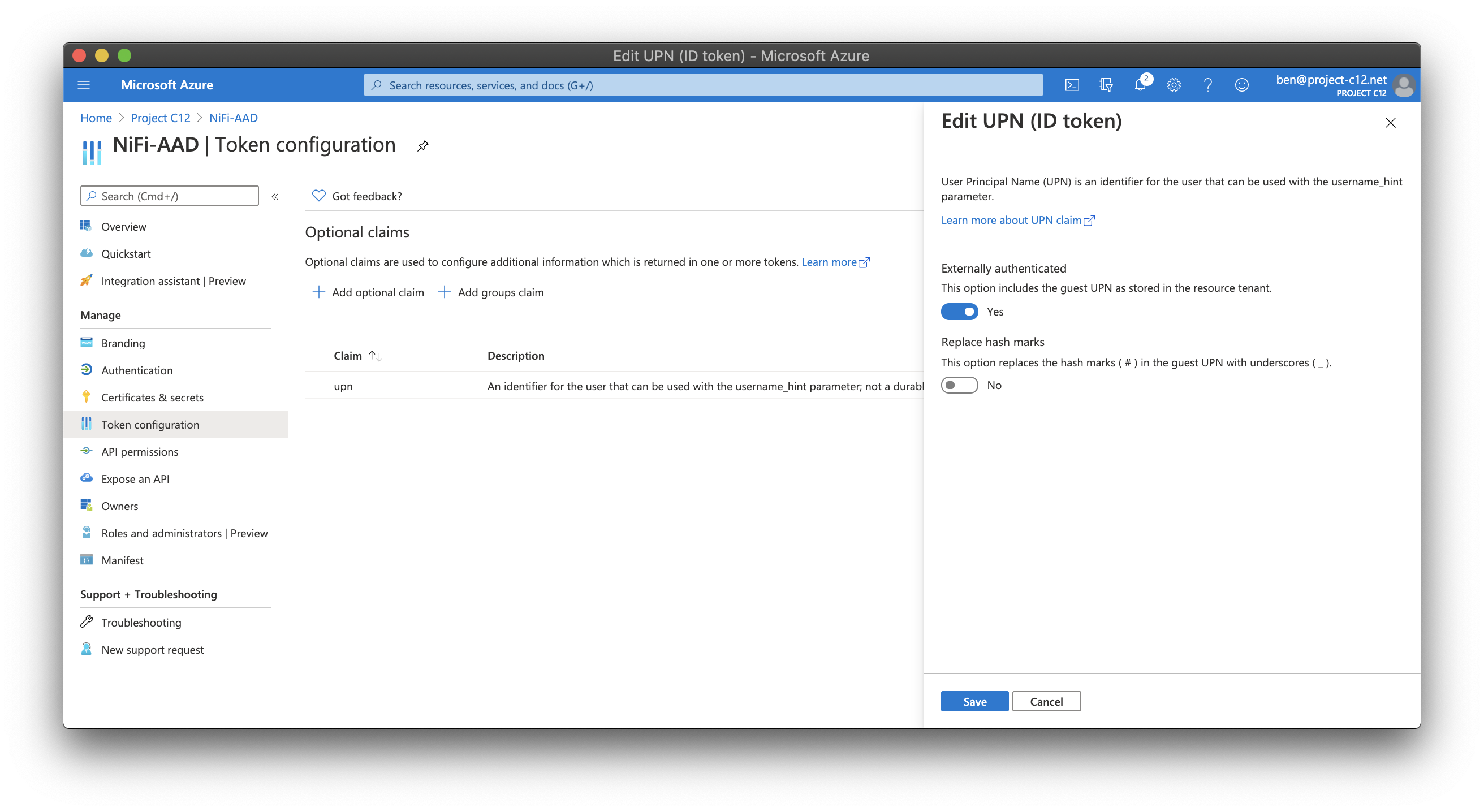
- Now Create the NiFi Groups access and polices NiFi will enforce.
- in the portal.azure.com, navigate to Azure Active Directory, and select Groups.
- To create a group select
+New group and create your group and add users to it as members or owners.NOTE the Prex you give you groups is important for the NiFi AAD Group sync module to function correctly.
i.e. label your user and admin groupNifi-AAD-{admin OR user}
Allowing the configuration of"GROUP_FILTER_PREFIX"=Nifi-AADinconf/authorizers.xmlto process both user lists and attach different policies on each independent group within NiFi.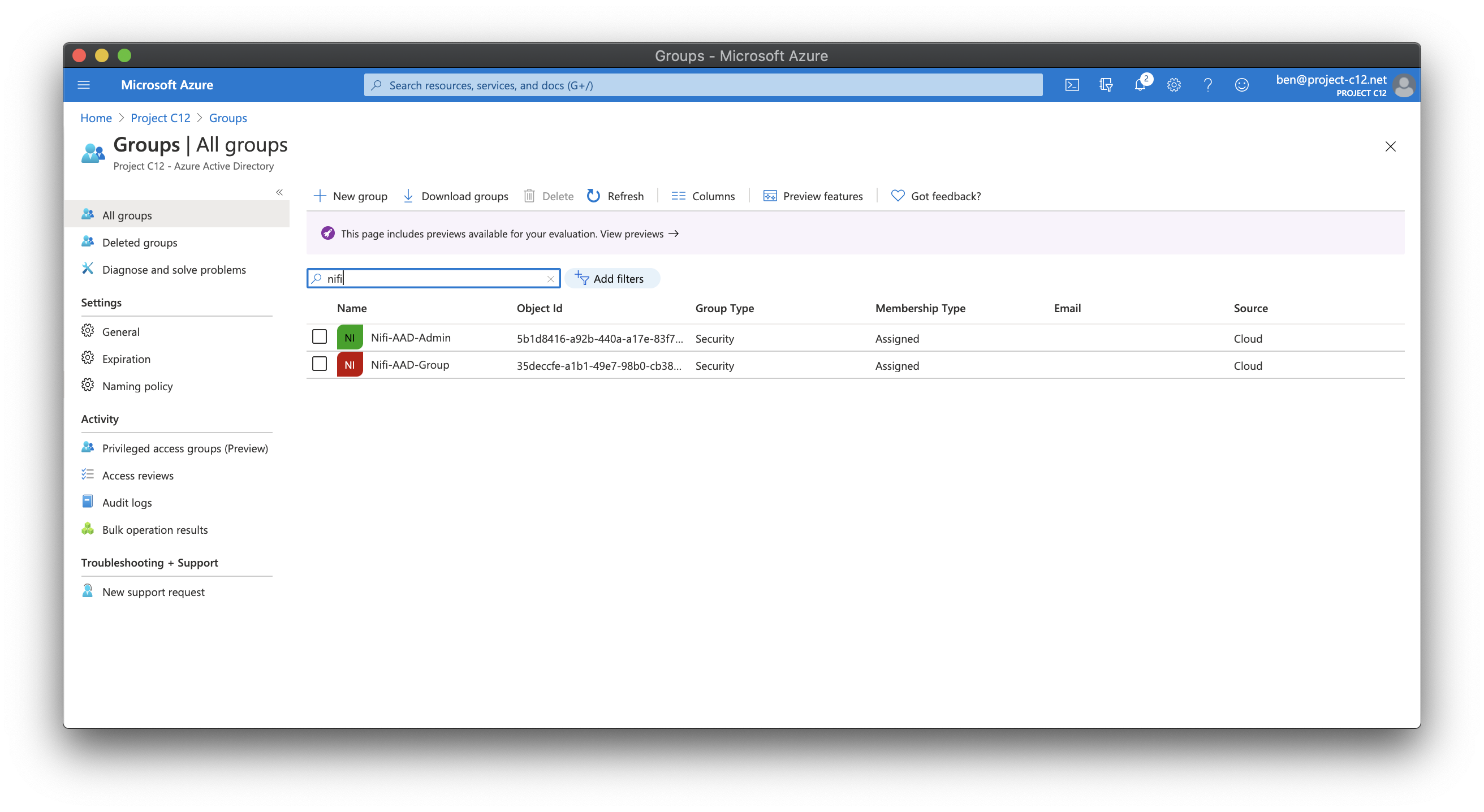
-
Set up NiFi to run over TLS as required for User-based Authentication to be enabled. For more information see the Nifi-toolkit walkthrough about enabling TLS for a local instance.
-
Set up you OpenId properties to point to the created prevously. These are located in
conf/nifi.properties.
# OpenId Connect SSO Properties #
nifi.security.user.oidc.discovery.url=https://login.microsoftonline.com/<YOUR_TENENT_ID>/v2.0/.well-known/openid-configuration
nifi.security.user.oidc.connect.timeout=5 secs
nifi.security.user.oidc.read.timeout=5 secs
nifi.security.user.oidc.client.id=<YOUR_APPLICATION_CLIENT_ID>
nifi.security.user.oidc.client.secret=<YOUR_APPLICATION_CLIENT_SECRET>
nifi.security.user.oidc.preferred.jwsalgorithm=
nifi.security.user.oidc.additional.scopes=profile
nifi.security.user.oidc.claim.identifying.user=upnIf your AAD includes both users from on-premise and cloud only account, and youur NiFi distribution version is above 1.13.0 (that is, including this PR: apache/nifi#4630), you could use email claim by default and upn as a fallback claim for identifying users. For example,
nifi.security.user.oidc.claim.identifying.user=email
nifi.security.user.oidc.fallback.claims.identifying.user=upn- Next, configure
conf/authorizers.xmlto enable afile-user-group-providerprovider for initial SystemAdminastration and theaad-user-group-providerfor Group Sync.
Example authorizers.xml:
<authorizers>
<userGroupProvider>
<identifier>file-user-group-provider</identifier>
<class>org.apache.nifi.authorization.FileUserGroupProvider</class>
<property name="Users File">./conf/users.xml</property>
<property name="Legacy Authorized Users File"></property>
</userGroupProvider>
<userGroupProvider>
<identifier>aad-user-group-provider</identifier>
<class>org.apache.nifi.authorization.azure.AzureGraphUserGroupProvider</class>
<property name="Refresh Delay">5 mins</property>
<property name="Authority Endpoint">https://login.microsoftonline.com</property>
<property name="Directory ID">YOUR_TENANT_ID</property>
<property name="Application ID">YOUR_APPLICATION_CLIENT_ID</property>
<property name="Client Secret">YOUR_APPLICATION_CLIENT_SECRET</property>
<property name="Group Filter Prefix">Nifi-AAD</property>
<property name="Page Size">100</property>
</userGroupProvider>
<userGroupProvider>
<identifier>composite-configurable-user-group-provider</identifier>
<class>org.apache.nifi.authorization.CompositeConfigurableUserGroupProvider</class>
<property name="Configurable User Group Provider">file-user-group-provider</property>
<property name="User Group Provider 1">aad-user-group-provider</property>
</userGroupProvider>
<accessPolicyProvider>
<identifier>file-access-policy-provider</identifier>
<class>org.apache.nifi.authorization.FileAccessPolicyProvider</class>
<property name="User Group Provider">composite-configurable-user-group-provider</property>
<property name="Authorizations File">./conf/authorizations.xml</property>
<property name="Initial Admin Identity">SYS_ADMIN_AAD_UPN</property>
<property name="Legacy Authorized Users File"></property>
<property name="Node Identity 1"></property>
</accessPolicyProvider>
<authorizer>
<identifier>managed-authorizer</identifier>
<class>org.apache.nifi.authorization.StandardManagedAuthorizer</class>
<property name="Access Policy Provider">file-access-policy-provider</property>
</authorizer>
</authorizers>As mentioned before, if you configure to use email claim by default and upn as a fallback for identifying users, set the CLAIM_FOR_USERNAME property of AzureGraphUserGroupProvider to email. By default, it will take upn claim, since this claim may cover both on-premise & cloud only user accounts.
NOTE To obtain the
SYS_ADMIN_AAD_UPNvalue can be done by going to portal.azure.com, navigate to Azure Active Directory, and select User, Search for the user wished to be used for the Initial System Administration and fetching theirUser Principal Namevalue from the properties.
-
Now run you NiFi instance with the Configuration, logging onto the NiFi web appl now should re-direct you to a Microsoft Branded Login portal.
-
Login with the User that the
SYS_ADMIN_AAD_UPNwas specified for.NOTE You may need to accept logging into a Non-Microsoft Application for the First time.
As AAD Admin; selectingConsent on behalf of your organizationshould avoid this from happening again.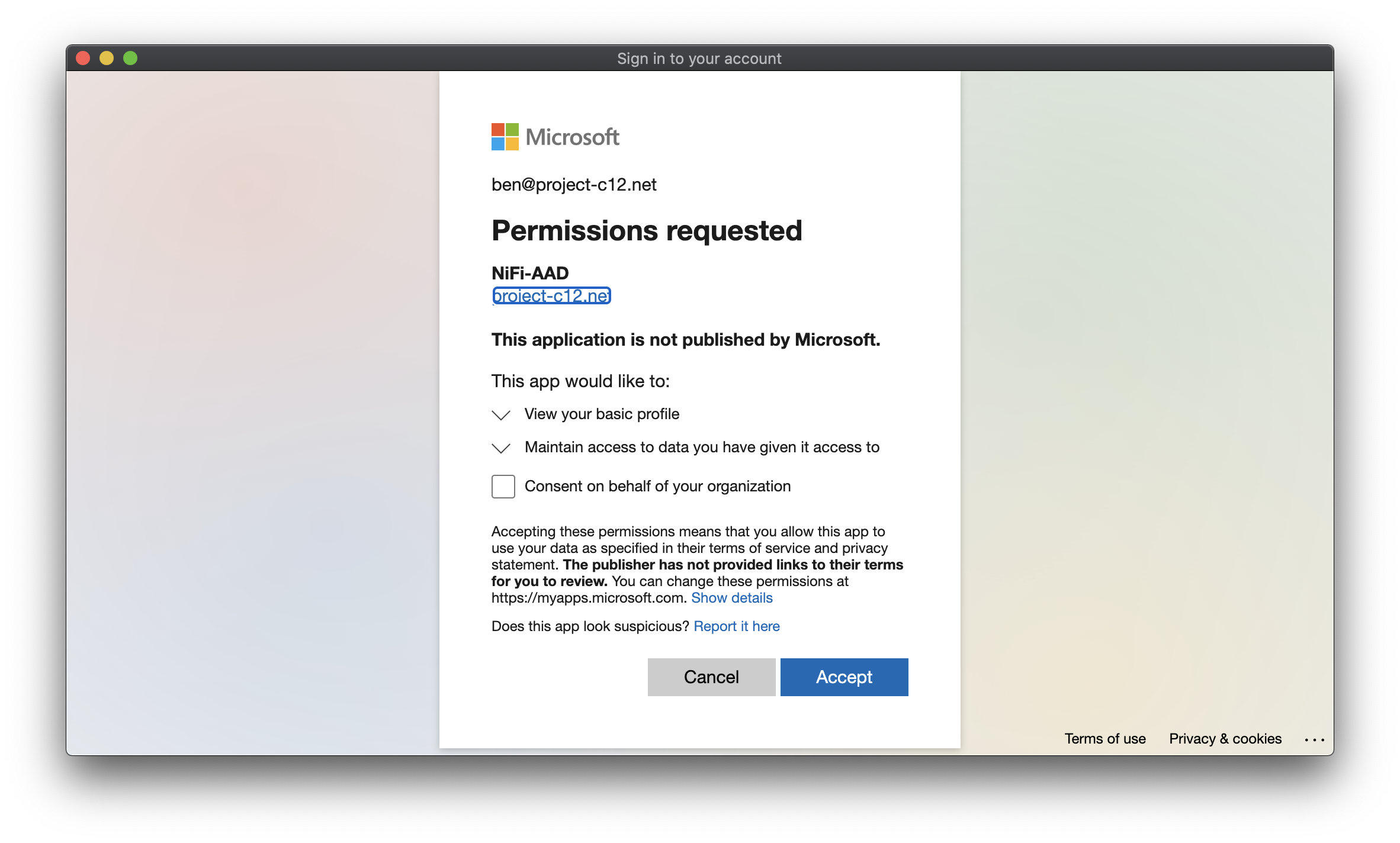
-
You should now have been successfully authenticated and redirected into the NiFi Canvas.
-
To verify the AAD Group Sync Provider is working and picking the created Groups, select the hamburger menu (top-right) and select Users, their should be User Principal Name (UPN) references for all the users within the AAD Groups and also the Groups listed also.

-
To Enforce Groups to certain abilities and pollicies, select again the hamburger menu (top-right) and select Policies.
-
Now select each policy you wish to enforce, then select the add button the right of the table, and type in the group you wish to have entitlement to that policy.
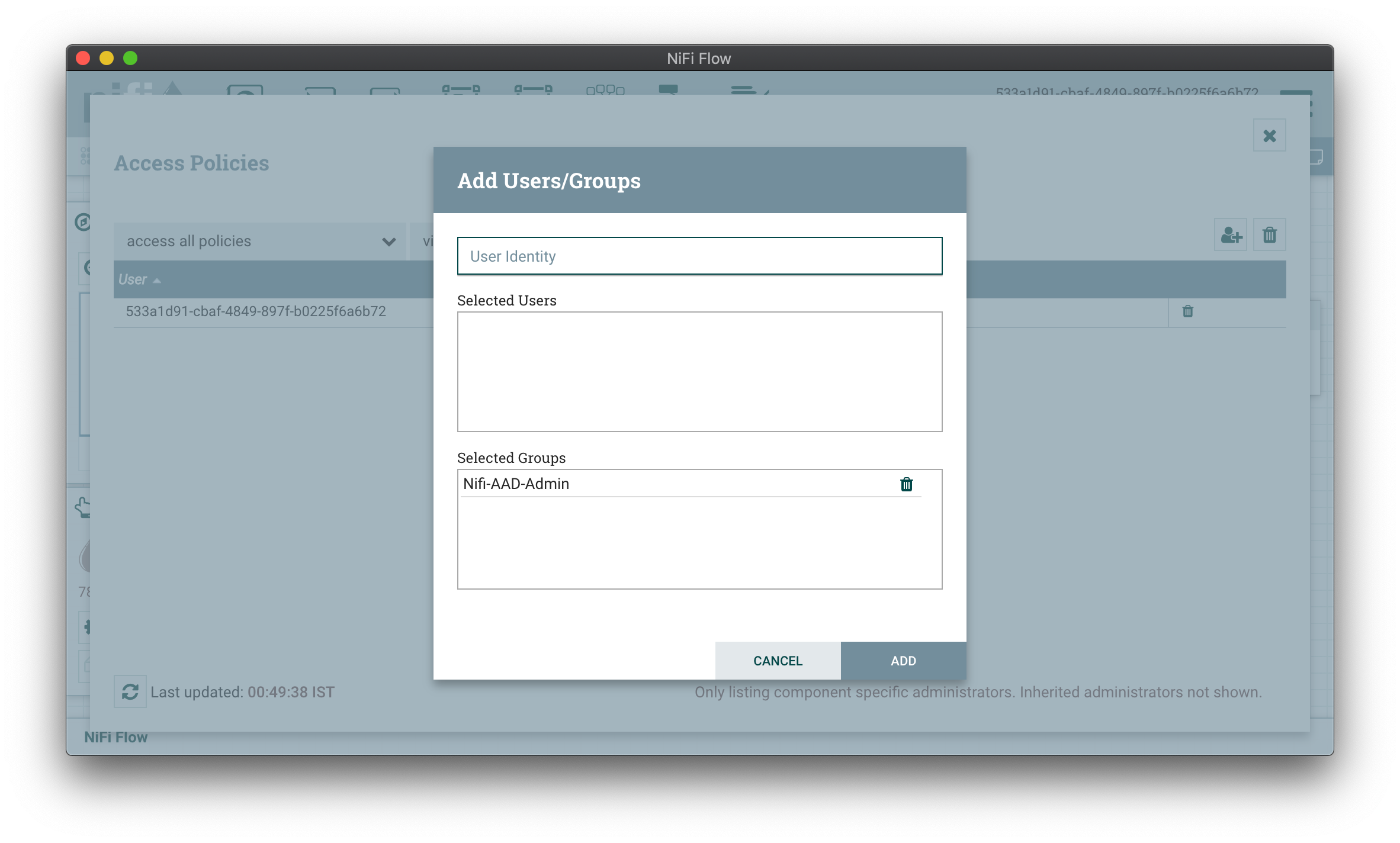
-
Now Users in that AAD group will have access to that policy when they login.
